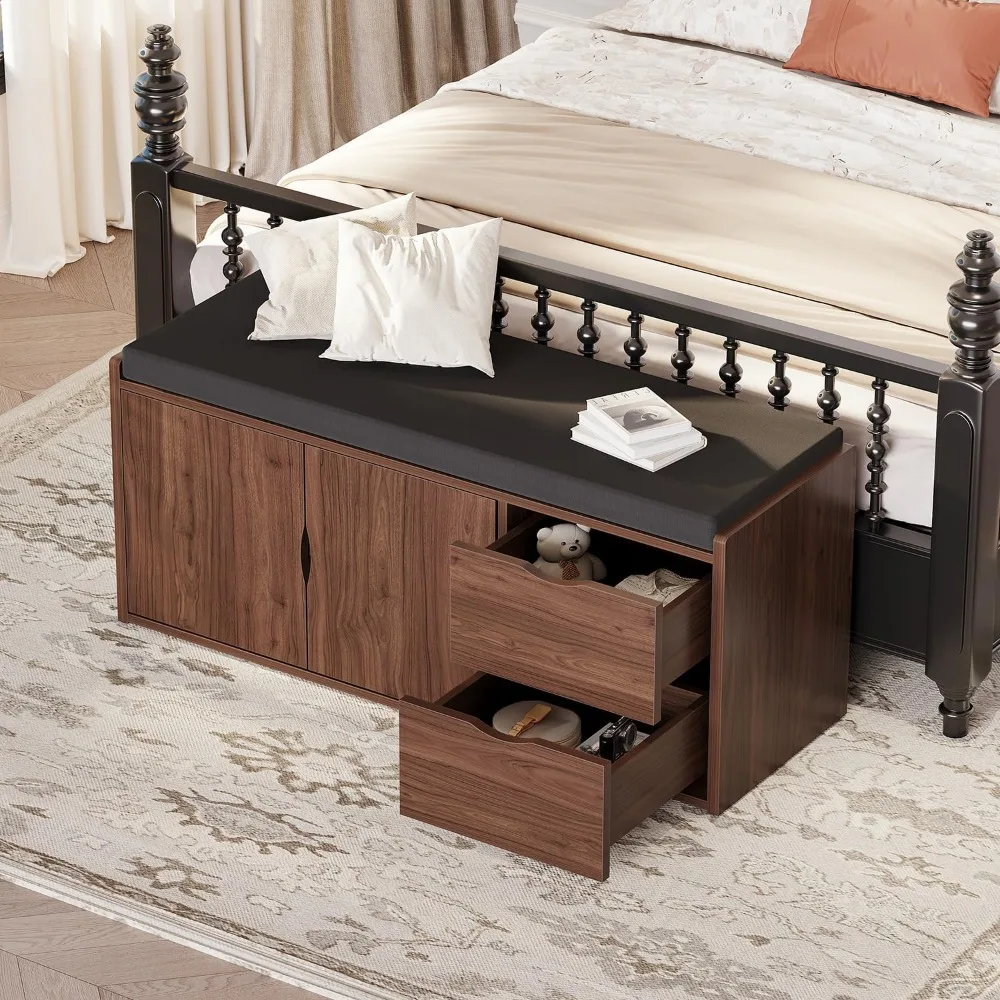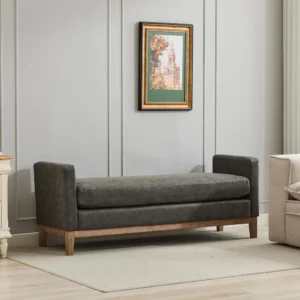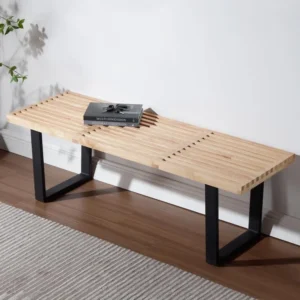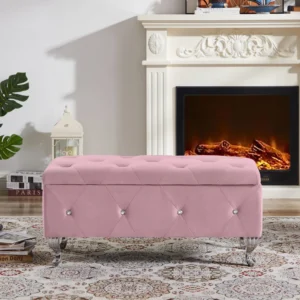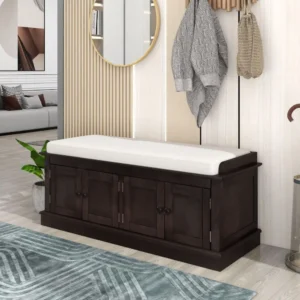Understanding Your Entry Space and Needs
The entry of your home creates that crucial first impression while serving as a transition space between the outside world and your personal sanctuary. An upholstered entry bench brings both practicality and style to this important area, providing a comfortable spot to sit while removing shoes, a surface for bags and packages, and an aesthetic anchor that sets the tone for your home’s design language.
Unlike purely functional storage options, upholstered benches add a layer of comfort and softness to what might otherwise be a purely utilitarian space. The cushioned seating transforms a mundane daily activity—removing and putting on shoes—into a more comfortable experience. Additionally, the fabric element introduces color, texture, and pattern possibilities that can either complement or make a statement in your entryway.
Before diving into specific bench features, taking time to evaluate your unique entryway needs ensures you’ll select a piece that enhances your daily routine rather than becoming an obstacle. Consider how many people will regularly use the bench, what items you need to store nearby, and how the bench will integrate with your existing decor. The perfect bench balances form and function in proportions specific to your household’s lifestyle.
Pre-Shopping Checklist:
– Measure your available entryway space (width, depth, height)
– Identify your primary needs (seating, storage, or both)
– Consider your entryway traffic patterns and bench placement
– Determine your style preferences and existing decor elements
Many homeowners find that space-saving benches for entryways offer the perfect balance of functionality without overwhelming smaller spaces. When selecting from upholstered entry benches with cushions, consider both comfort and how the bench will serve your specific entryway challenges.
Measuring Your Space Correctly
Accurate measurements form the foundation of a successful entry bench purchase. Start by measuring the width of your available wall space where the bench will sit. Use a tape measure to determine the maximum length your bench can be, keeping in mind that you’ll want some visual breathing room on either side—typically 4-8 inches minimum.
Next, measure the depth of space extending from the wall, considering traffic patterns. A standard hallway should maintain at least 36 inches of clearance for comfortable passage. For entryways where the bench sits opposite a door, account for the full swing arc of the door plus additional clearance (approximately 30-36 inches from the fully open door position).
Height considerations are equally important but often overlooked. Standard bench seat heights range from 18-20 inches—ideal for comfortable shoe removal. If your bench will sit beneath hooks, a mirror, or artwork, ensure adequate clearance above the bench (typically 12-15 inches minimum above the bench seat).
| Bench Type | Typical Width | Typical Depth | Typical Height |
|---|---|---|---|
| Small | 36-42 inches (91-107 cm) | 16-18 inches (41-46 cm) | 18-20 inches (46-51 cm) |
| Medium | 48-54 inches (122-137 cm) | 18-20 inches (46-51 cm) | 18-20 inches (46-51 cm) |
| Large | 60+ inches (152+ cm) | 20-24 inches (51-61 cm) | 18-20 inches (46-51 cm) |
For homes with limited space, small sized entryway benches can provide functionality without overwhelming the area. Similarly, narrow entryway benches for tight spaces are specifically designed to offer seating and storage in more compact entryways while maintaining proper traffic flow.
Upholstery Materials: Choosing the Right Fabric
The upholstery material you select significantly impacts both the appearance and longevity of your entry bench. Since entryways endure frequent use and exposure to outdoor elements, durability becomes a primary consideration alongside aesthetic appeal.
Natural fabrics offer timeless appeal but come with specific maintenance considerations:
– Cotton: Breathable and soft with numerous pattern options, though prone to staining and wrinkling
– Linen: Provides a relaxed, natural texture but may show wear quickly in high-traffic areas
– Wool: Naturally stain-resistant and durable but higher maintenance and potentially scratchy
Synthetic and performance fabrics typically offer superior durability for entryway conditions:
– Polyester: Affordable, fade-resistant, and available in countless colors and textures
– Nylon: Extremely durable with excellent stain resistance, though sometimes less soft to touch
– Olefin: Highly stain-resistant and colorfast, making it ideal for homes with children
– Performance fabrics (like Sunbrella or Crypton): Engineered specifically for stain resistance, durability, and easy cleaning—often worth the investment for entry areas
Leather and leather alternatives deserve special consideration:
– Genuine leather: Develops a rich patina over time, easily wipes clean, but requires occasional conditioning and can be damaged by sharp objects
– Faux leather/vinyl: More affordable and often more stain-resistant than genuine leather, though generally less breathable and potentially less durable long-term
The ideal upholstery choice depends on your household’s specific needs. Homes with young children or pets might prioritize performance fabrics with stain-resistant treatments, while design-focused households might prefer the texture and natural variations of linen or velvet despite higher maintenance requirements.
Maintaining different upholstery materials properly will extend the life of your bench significantly. When browsing cushioned benches with different upholstery options, consider requesting fabric samples to test how they feel and how easily they clean before making your final selection.
Frame Construction and Materials
Behind every beautiful upholstered bench is a frame that determines its durability, weight capacity, and longevity. Understanding frame construction helps you invest wisely in a piece that will stand the test of time.
Wood Frames:
– Solid hardwood (oak, maple, walnut): Offers exceptional durability and stability; can last decades with proper care
– Solid pine or other softwoods: More affordable but potentially less durable; may be prone to denting
– Engineered wood/plywood: Quality varies widely; multiple-ply construction can be quite sturdy while particleboard may deteriorate faster
Metal Frames:
– Steel: Provides maximum strength and durability with minimal bulk
– Aluminum: Lightweight yet strong; resistant to rust but may not have the weight-bearing capacity of steel
– Mixed metal frames: Often combine strength with decorative elements
Quality joinery methods signify attention to detail in construction:
– Mortise and tenon joints create strong wood-to-wood connections without relying solely on fasteners
– Corner blocking reinforces frame corners, preventing wobbling over time
– Dowel joinery provides invisible strength at critical connection points
– Screwed and glued joints offer superior stability compared to stapled connections
Weight capacity directly relates to frame construction—most entry benches should support at least 250-300 pounds, but this varies based on length and design. Benches with storage features typically require additional structural support to maintain integrity when loaded with items.
For households seeking long-term investments, solid wood frames typically offer the best combination of durability and repairability. Our collection of wood frame entry benches provides options that balance structural integrity with beautiful design elements.
Storage Features and Functionality
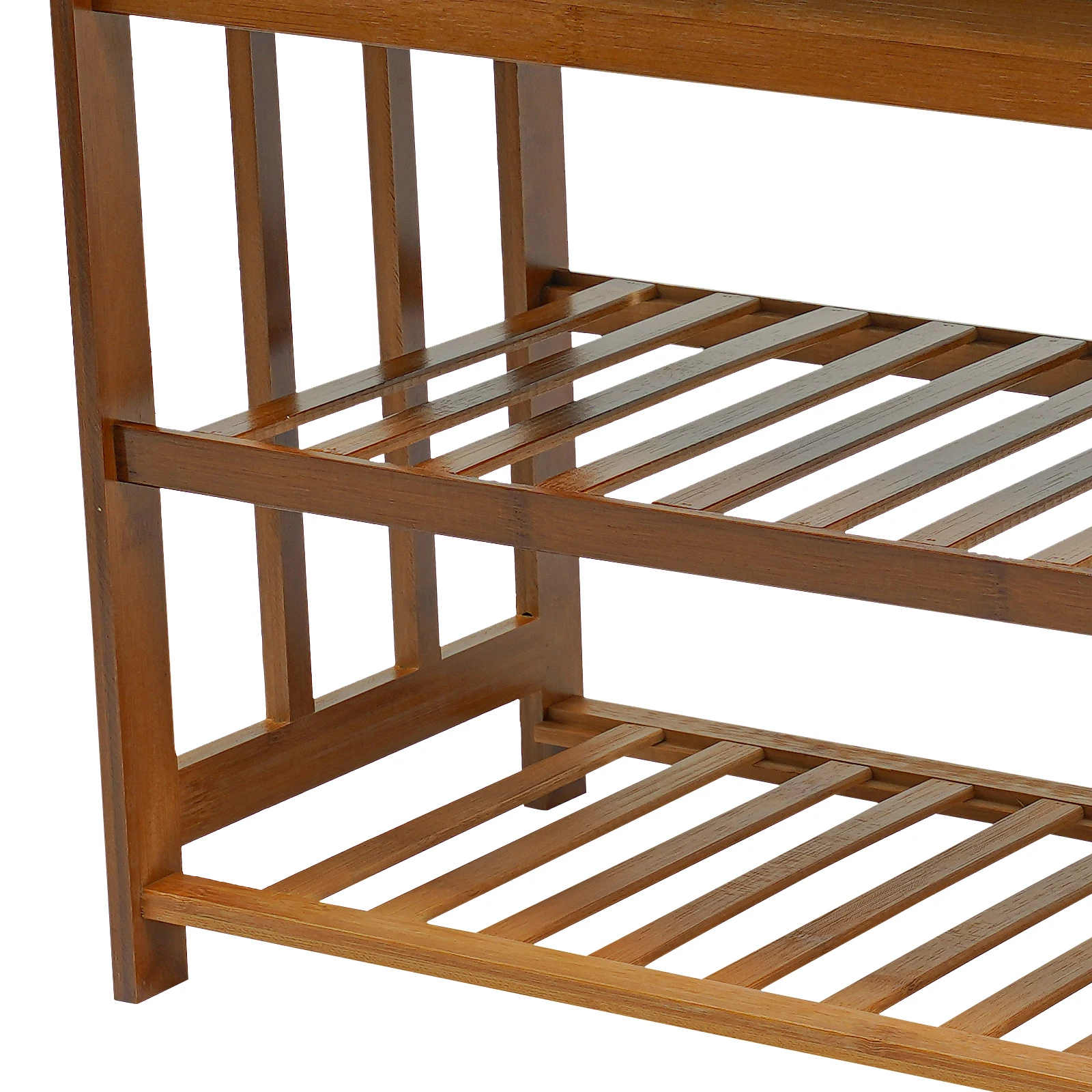
The right storage configuration transforms an ordinary bench into an organizational powerhouse for your entryway. Different storage types serve distinct organizational purposes:
Lift-top Storage:
– Provides concealed storage in a single large compartment
– Perfect for storing seasonal items, guest slippers, or bulky accessories
– Typically features hydraulic hinges for safe, slow closing
– Offers the cleanest visual appearance with no visible compartments
Drawer Storage:
– Allows for categorized organization and easy access
– Ideal for smaller items like gloves, scarves, and pet accessories
– Available in single large drawer or multiple smaller drawer configurations
– Prevents items from becoming lost in a larger compartment
Open Shelving/Cubbies:
– Provides immediate visibility and access to stored items
– Perfect for frequently used shoes (typically fits 4-8 pairs depending on size)
– Often includes dividers to maintain organization
– Can be enhanced with decorative baskets for a more polished look
Combination Storage:
– Incorporates multiple storage types for maximum versatility
– Might include both drawers and open shelving or lift-top with additional compartments
– Offers the most organizational potential but may have a larger footprint
– Best for primary entryways serving multiple household members
When evaluating storage options, consider your typical entryway clutter and which configuration would best address your specific organizational challenges. For example, households with children might benefit from open cubbies for easy shoe access, while those seeking a cleaner appearance might prefer the hidden storage of a lift-top design.
Exploring smart entryway storage seating solutions can help you maximize functionality in your space. For those specifically needing drawer storage, our entry benches with drawer storage collection offers various configurations to meet different organizational needs.
Comfort and Support Features
While functionality often drives bench selection, comfort determines how much you’ll actually use the seating feature. Several elements contribute to the overall comfort of an upholstered entry bench:
Cushion Composition:
– High-density foam (1.8 lbs/cubic foot or higher) provides firm support that maintains its shape
– Memory foam offers superior comfort for longer sitting periods but may be less durable long-term
– Wrapped foam (foam core wrapped in batting or down alternative) combines support with a softer surface feel
– Thicker cushions (3-5 inches) generally provide more comfort than thinner options (1-2 inches)
Seat Dimensions:
– Ideal seat depth ranges from 16-20 inches—shallow enough for proper posture while putting on shoes
– Width per person should be approximately 20-24 inches for comfortable seating
– The optimal perfect height for an entryway bench typically falls between 17-19 inches from floor to seat top, aligning with ergonomic standards for easy sitting and standing
Support Systems:
– Sinuous springs provide consistent support and prevent cushion sagging over time
– Webbing systems offer a more economical option but may have less longevity
– Reinforced seating areas withstand daily use without developing uncomfortable pressure points
Additional Comfort Features:
– Padded armrests provide comfort and support when sitting for longer periods
– Slight backward seat angles (2-5 degrees) can enhance comfort for longer sitting sessions
– Properly tensioned cushions strike the balance between too firm and too soft
For households where the bench will primarily serve quick transitions (putting on/removing shoes), prioritize proper height and stable support over plush cushioning. However, if your entry bench might double as additional seating for gatherings or longer waits, investing in higher-quality cushioning becomes more important for comfort.
Style Elements That Complement Your Home
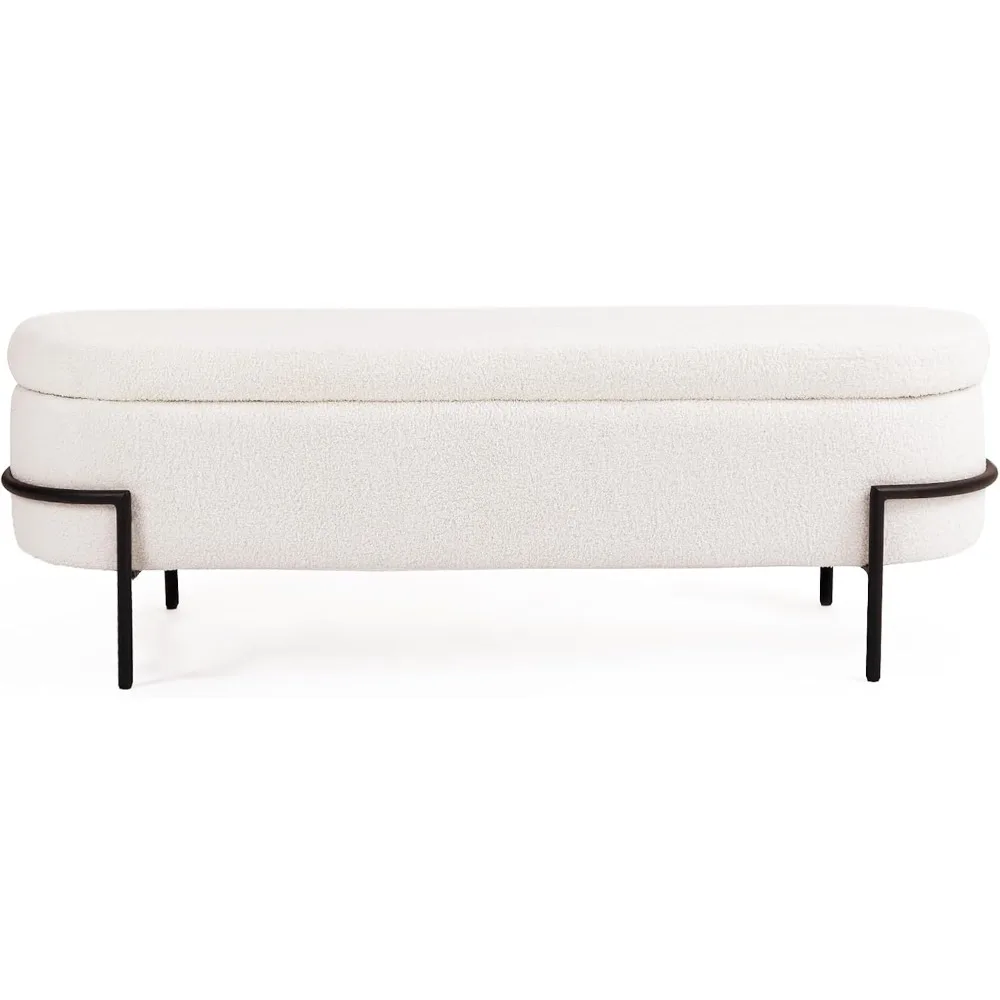
An upholstered entry bench serves as both a functional piece and a style statement that sets the tone for your home. Matching your bench to your existing decor creates a cohesive, thoughtful entrance that welcomes guests with a glimpse of your design aesthetic.
Bench Leg Styles and Their Design Implications:
– Tapered legs: Sleek and angled, perfect for mid-century modern and contemporary spaces
– Turned legs: Featuring curves and detailing, ideal for traditional, cottage, or farmhouse styles
– Block legs: Substantial and squared-off, complementing craftsman and modern rustic designs
– Hairpin legs: Thin metal legs that add an airy, retro-modern feel
– Hidden legs/skirted designs: Create a more formal, upholstered look without visible leg detail
Decorative Upholstery Elements:
– Tufting: Diamond or button tufting adds texture and traditional elegance
– Channel stitching: Vertical or horizontal stitched channels create a tailored, contemporary look
– Nailhead trim: Metal studs outlining edges add definition and transitional style
– Piping/welting: Fabric-covered cording defines edges and adds tailored detail
– Pleating: Gathered fabric creates visual interest and a more formal appearance
Color Selection Strategies:
– Choose upholstery that either complements (similar tones) or purposefully contrasts (accent color) with your existing decor
– Neutral tones (greige, taupe, navy, charcoal) provide versatility and longevity
– Consider the bench as a potential “bridge piece” that ties together other colors in adjacent rooms
– Pattern scale should relate to the bench size—larger benches can support larger patterns, while smaller benches benefit from smaller-scale or solid designs
For those drawn to cleaner lines and contemporary aesthetics, our modern style upholstered entry benches collection offers options that balance current design trends with timeless appeal. When selecting your bench style, consider not just your current decor but your overall design direction, as quality benches often remain in homes for many years.
Budget Considerations and Quality Markers
Understanding the relationship between price points and quality helps you make an informed investment in your entry bench. While prices vary based on size, materials, and features, certain general ranges and quality indicators can guide your shopping:
Entry-Level Price Range ($100-$300):
– Typically features engineered wood frames and basic polyester upholstery
– May include simple storage features like a single shelf
– Often requires assembly with basic hardware
– Quality markers: reinforced corners, smooth-operating drawers (if applicable), consistent upholstery application
Mid-Range Price Range ($300-$700):
– Usually includes higher-quality hardwood or metal frames
– Features better cushioning with higher-density foam
– Offers more sophisticated storage solutions
– May include design details like tufting or nailhead trim
– Quality markers: solid wood components, smooth drawer glides, quality hardware, reinforced stress points
Premium Price Range ($700+):
– Features kiln-dried hardwood frames with advanced joinery
– Includes premium upholstery materials (performance fabrics, genuine leather)
– Often showcases expert craftsmanship details and custom options
– Quality markers: dovetail drawer construction, full-extension drawer glides, eight-way hand-tied springs, double-doweled joints
When evaluating value, consider not just the initial price but the cost-per-use over the bench’s lifetime. A higher-quality bench that lasts 15+ years may ultimately prove more economical than replacing a lower-quality piece every 3-5 years. Additionally, benches with classic designs tend to remain stylistically relevant longer than highly trendy pieces.
For those working within specific budget constraints, exploring affordable entryway bench solutions can help you identify the best value for your investment while still addressing your functional needs.
Practical Considerations Before Purchase
Beyond style, materials, and dimensions, several practical factors deserve attention before finalizing your bench selection:
Assembly Requirements:
– Fully assembled benches eliminate setup headaches but may present delivery challenges
– Partially assembled options typically require attaching legs or simple components
– Complete assembly kits require more time but often cost less
– Average assembly time ranges from 15-90 minutes depending on complexity
– Common tools needed include screwdrivers, Allen wrenches (often included), and occasionally a hammer
Delivery Logistics:
– Measure doorways, hallways, and stairwells if applicable
– Consider any tight corners the bench must navigate during delivery
– Verify if white-glove delivery options are available for larger pieces
– Note that fully assembled benches require more clearance than boxed, unassembled pieces
Warranty Considerations:
– Frame warranties typically range from 1-5 years
– Upholstery warranties are generally shorter, often 1-2 years
– Look for coverage of both structural elements and cushioning materials
– Understand what constitutes “normal wear” versus covered defects
Before Finalizing Your Purchase:
– Read the return policy carefully, noting any restocking fees
– Verify if return shipping is your responsibility for online purchases
– Check if the bench comes with care instructions for both frame and upholstery
– Consider ordering fabric swatches first for online purchases to ensure color accuracy
Taking time to understand these practical elements helps avoid post-purchase frustrations. The comprehensive guide for selecting the right bench offers additional insights into these considerations, helping you navigate the selection process more confidently.
Maintenance and Care for Longevity
Proper care significantly extends the life and appearance of your upholstered entry bench. Understanding fabric cleaning codes provides a foundation for appropriate maintenance:
– Code W: Clean with water-based products only
– Code S: Clean with solvent-based products only (dry-cleaning solutions)
– Code W/S: Can be cleaned with either water or solvent-based products
– Code X: Professional cleaning only or vacuum only
Establish a regular maintenance schedule based on your bench’s materials and usage level:
– Weekly: Light vacuuming with an upholstery attachment to remove dust and debris
– Monthly: More thorough cleaning of frame and hardware; spot-checking for stains
– Quarterly: Deep cleaning based on manufacturer recommendations
– Annually: Inspection of structural elements, tightening of any loose hardware
For common spills, quick action is crucial:
– Blot (don’t rub) liquid spills immediately with clean, white cloths
– For water-safe fabrics, use a mixture of mild soap and water for most spots
– Test any cleaning solution on an inconspicuous area first
– Allow cleaned areas to dry completely before using the bench
Professional cleaning may be necessary for persistent stains or periodic refreshing, particularly for Code X fabrics or benches in high-traffic entryways. Consider applying fabric protectors designed for upholstery to enhance stain resistance, especially for lighter-colored fabrics.
Styling Your Entry Bench: Tips and Accessories
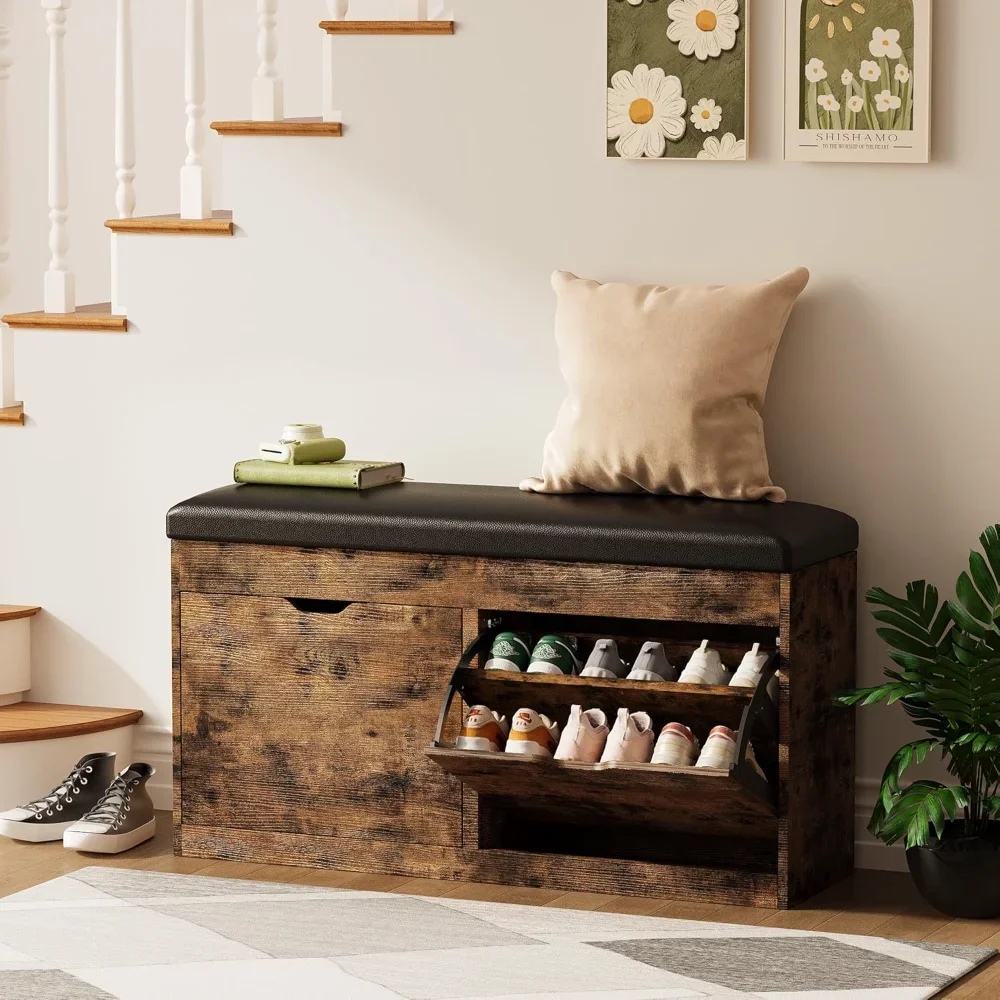
Transforming your entry bench from a functional piece to a design focal point involves thoughtful styling that balances aesthetics with practicality. The right accessories complement your bench while maintaining its usability.
Wall Pairings That Enhance Your Bench:
– Hang a mirror directly above to create a functional getting-ready station and visually expand the space
– Install wall hooks or a coat rack at appropriate heights for convenient outerwear storage
– Consider a complementary piece of wall art that ties into your color scheme
– For narrow entries, wall sconces provide lighting without requiring valuable surface space
Textile Layering Strategies:
– Add 1-2 decorative pillows (16”×16” or 12”×20”) in complementary or contrasting fabrics
– Introduce a throw blanket folded neatly for both visual interest and practical warmth
– Use an entry rug that extends 6-12 inches beyond the bench on all sides
– Consider seasonal pillow covers to refresh your entry’s look throughout the year
Entryway Bench with Cushion, Mudroom Bench with Cushion, Shoe Bench for Entryway
$1,186.63 Select options This product has multiple variants. The options may be chosen on the product pageEntryway Bench with Back, Modern Entryway Bench, Shoe Bench for Entryway
Price range: $463.13 through $474.44 Select options This product has multiple variants. The options may be chosen on the product pageCorner Entryway Bench, Entryway Bench with Cushion, Modern Entryway Bench, Shoe Bench for Entryway
$476.34 Select options This product has multiple variants. The options may be chosen on the product pageModern Entryway Bench, Wood Entryway Bench, Wood Mudroom Bench
$497.69 Select options This product has multiple variants. The options may be chosen on the product pageEntryway Bench with Cushion, Small Entryway Bench
$466.79 Select options This product has multiple variants. The options may be chosen on the product pageEntryway Bench with Cushion, Mudroom Bench with Cabinets, Shoe Bench for Entryway, Shoe Bench with Cushion
$991.71 Select options This product has multiple variants. The options may be chosen on the product page
Creating a Cohesive Entryway:
– Maintain a consistent color palette with 2-3 primary colors plus accent tones
– Echo materials or finishes from the bench in other entry elements (similar wood tones or metal finishes)
– Balance hard surfaces with soft textiles for visual and tactile contrast
– Layer lighting (ambient, task, and accent) to create depth and functionality
Understanding what items complement an entryway bench helps create a cohesive and functional entry space. Consider adding a small table or plant stand adjacent to the bench to create a complete entryway vignette that serves both practical and aesthetic purposes.
Common Questions When Choosing an Entry Bench
Can an upholstered bench work in a small entryway?
Absolutely! The key is selecting appropriately scaled pieces. A bench 36-42 inches wide with a depth under 18 inches can work well in compact spaces. Consider upholstered entry benches for small foyers that are specifically designed with space constraints in mind. Look for models with built-in storage to maximize functionality without additional furniture pieces.
How do I protect upholstery in high-traffic areas?
Select fabrics specifically engineered for high-performance like solution-dyed acrylics, polyester blends with stain-resistant treatments, or crypton fabrics. Apply fabric protector products designed for upholstery, following manufacturer guidelines. Consider darker colors or patterns that disguise minor soiling between cleanings. For maximum protection, place a small washable runner or mat in front of the bench to catch the initial dirt from shoes.
Should my bench match other furniture pieces?
Rather than exact matching, aim for coordination. Your bench should complement your overall design scheme through consistent elements like wood tone, metal finish, or fabric color family. Think of your bench as a bridge piece that can connect different areas of your home visually. If your home features mixed furniture styles, select a bench that incorporates elements from both to create cohesion.
What’s the best upholstery for homes with pets?
Look for tightly woven fabrics with minimal texture for fewer snag opportunities. Performance fabrics like Crypton or Sunbrella resist stains, odors, and bacteria while being easy to clean. Leather and high-quality vinyl can be excellent options as they don’t trap pet hair and can be wiped clean. Avoid delicate weaves like silk or loose weaves that easily catch claws. Dark, patterned fabrics show hair and scratches less than solid light colors.
For more insights into whether an entry bench suits your specific needs, explore our guide answering common questions about entryway benches.
Making Your Final Decision: Selection Framework
After considering all the factors that contribute to the perfect upholstered entry bench, creating a simple decision framework helps prioritize what matters most for your specific situation:
Priority Assessment System:
1. Identify your non-negotiable features (must-haves)
2. List your desired features (nice-to-haves)
3. Determine your absolute constraints (budget, size limitations)
4. Create a simple scoring system for potential benches
For example, if storage is your primary concern while upholstery type is secondary, you might weight storage solutions more heavily in your evaluation. Similarly, if budget is tight but quality matters, you might prioritize solid construction with simpler design elements.
Sample Decision Matrix:
For each bench option you’re considering, score features on a scale of 1-5, then multiply by your personal importance weighting (1-3) for that feature:
– Size fit for space (Weight: _)
– Storage functionality (Weight: )
– Comfort/cushioning (Weight: _)
– Upholstery material (Weight: )
– Style match (Weight: _)
– Construction quality (Weight: _)
– Budget fit (Weight: ____)
This approach helps objectively compare different options while accounting for your unique priorities. Remember that the perfect bench balances practical considerations with aesthetic appeal—it should solve organizational challenges while enhancing your home’s entrance.
For those still exploring options for maximizing their entry organization, learning how to organize a small entryway with a bench provides valuable insights for creating functional, attractive entry spaces regardless of size limitations.
At Nested Goods, we believe the right entry bench becomes more than furniture—it’s the foundation of an organized, welcoming home entrance that sets the tone for your entire living space.

